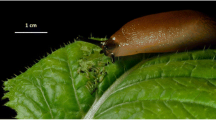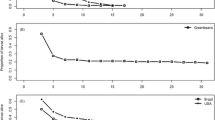Abstract
Plant secondary chemistry can vary among plant tissues, individuals, and populations, and this variation has population-level consequences for upper trophic levels. In this study, we examined the multi-trophic consequences of variation in iridoid glycosides, which are a component of plant defense against generalist herbivores and also contribute to the unpalatability of sequestering herbivores to both vertebrate and invertebrate predators. Several populations of Catalpa bignonioides were located and examined for the presence of the Catalpa Sphinx, Ceratomia catalpae, a specialist herbivore of Catalpa. We quantified iridoid glycoside content in Catalpa Sphinx caterpillars and in damaged and undamaged C. bignonioides leaves. Overall, leaves of C. bignonioides that were damaged by Catalpa Sphinx caterpillars contained lower concentrations of two major iridoid glycosides, catalpol and catalposide, than leaves of undamaged trees from naturally occurring populations. Catalpa Sphinx caterpillars sequester only catalpol, and increasing catalpol and catalposide concentrations in leaves were associated with increased catalpol sequestration by caterpillars. The parasitoid Cotesia congregata develops successfully inside catalpol-sequestering Catalpa Sphinx caterpillars, and we examined parasitoid larvae for the presence of catalpol. Parasitoid larvae dissected from caterpillars contained catalpol, but at lower concentrations than their host caterpillars. The variation in chemical defense documented here has rarely been documented over multiple trophic levels, but such resolved systems are ideal for examining competing hypotheses about the effects of plant secondary metabolites on higher trophic levels.



Similar content being viewed by others
References
AGRAWAL, A.A., TUZUM, S. and BENT, E. 1999. Induced Plant Defenses Against Pathogens and Herbivores: Biochemistry, Ecology, and Agriculture. APS Press, St. Paul, MN.
BAERG, W.J. 1935. Three shade tree insects, II. Great elm leaf beetle, catalpa sphinx, and eastern tent caterpillar. Univ. Ark. Exp. Station Bull. 317: 1–27.
BALDWIN, I.T. 1987. Mechanism of damaged-induced alkaloid production in wild tobacco. J. Chem. Ecol. 15: 1661–1680.
BARTON, K.E. 2008. Phenotypic plasticity in seedling defense strategies: compensatory growth and chemical induction. Oikos 117: 917–925.
BAUR, M.E. and YEARGAN, K.V. 1994. Developmental stages and kairomones from the primary parasitoid Cotesia marginiventris (Hymenoptera, Braconidae) affect the response of the hyperparasitoid Mesochorus discitergus (Hymenoptera, Ichneumonidae) to parasitized caterpillars. Ann. Entomol. Soc. Am. 87: 954–961.
BENN, M., DEGRAVE, J., GNANASUNDERAM, HUTCHINS. 1979. Host-plant pyrrolizidine alkaloids in Nyctemera annulata Boisduval: their persistence through the life-cycle and transfer to a parasite. Experientia 35: 731–732.
BOWERS, M.D. 1980. Unpalatability as a defense strategy of Euphydryas phaeton (Lepidoptera, Nymphalidae). Evolution 34: 586–600.
BOWERS, M.D. 1993. Aposematic caterpillars: Lifestyles of the warningly colored and unpalatable. pp. 331–371 in N. E. Stamp and T. Casey (eds.). Caterpillars: Ecological and Evolutionary Constraints on Foraging. Chapman & Hall, New York.
BOWERS, M.D. 2003. Hostplant suitability and defensive chemistry of the catalpa sphinx Ceratomia catalpae (Lepidoptera: Sphingidae). J. Chem. Ecol. 29: 2359–2367.
BOWERS, M.D. and FARLEY, S. 1990. The behavior of gray jays, Perisoreus canadensis, towards palatable and unpalatable Lepidoptera. Anim. Behav. 39: 699–705.
Bowers, M.D. and Stamp, N.E. 1993. Effects of plant age, genotype, and herbivory on Plantago performance and chemistry. Ecology 74: 1778–1791.
BROWER, L.P. 1958. Bird predation and foodplant specificity in closely related procryptic insects. Am. Nat. 92:183–187.
CAMARA, M.D. 1997. Predator responses to sequestered plant toxins in buckeye caterpillars: are tritrophic interactions locally variable? J. Chem. Ecol. 23: 2093–2106.
CAMPBELL, B.C. and DUFFEY, S.S. 1979. Tomatine and parasitic wasps – potential incompatibility of plant antibiosis with biological-control. Science 205: 700–702.
CAMPOS, F., DONSKOV, N., ARNASON, J.T., PHILOGENE, B.J.R., ATKINSON, J., MORAND, P., and WERSTIUK, N.H. 1990. Biological effect and toxicokinetics of DIMBOA in Diadegma terebrans (Hymenoptera: Ichneumonidae), an endoparasitoid of Ostrinia nubilalis (Lepidoptera: Pyralidae). J. Econ. Entomol. 83: 356–360.
CROCKER, V.M. 2008. Behavioral and Developmental Responses of the Parasitoid Cotesia congregata (Say) Differ with Respect to Plant-Host Origin: a Test for Local Adaptation. M.Sc. Thesis, Virginia Commonwealth University.
DYER, L.A. and BOWERS, M.D. 1996. The importance of sequestered iridoid glycosides as a defense against an ant predator. J. Chem. Ecol. 22: 1527–1539.
DYER, L.A., DODSON, C.D., and RICHARDS, J. 2004. Isolation, synthesis, and evolutionary ecology of Piper amides. pp. 117–139 in DYER, L.A. and A.N. PALMER (eds.). Piper. A model genus for studies of evolution, chemical ecology, and trophic interactions. Kluwer Academic Publishers, Boston.
FORDYCE, J.A. and NICE, C.C. 2008. Antagonistic, stage-specific selection on defensive chemical sequestration in a toxic butterfly. Evolution 62: 1610–1617.
FUCHS, A. and BOWERS, M.D. 2004. Patterns of iridoid glycoside production and induction in Plantago lanceolata and the importance of plant age. J. Chem. Ecol. 30: 1723–1741.
FUNG, S.Y. 1988. Butenolides in parasitoids and adults of small ermine moths, Yponomeuta spp. (Lepidoptera: Yponomeutidae). Proc. of the Koninklijke Nederlandse Akademi Van 91: 363–367.
GAINES, D.N. and KOK, L.T. 1999. Impact of hyperparasitoids on Cotesia glomerata in Southwestern Virginia. Biol. Cont. 14: 19–28.
GAULD, I.D., GASTON, K.J., and JANZEN, D.H. 1992. Plant allelochemicals, tritrophic interactions and the anomalous diversity of tropical parasitoids: the “nasty” host hypothesis. Oikos 65: 353–357.
GARDNER, D.R. and STERMITZ, F.R. 1988. Host plant utilization and iridoid glycoside sequestration by Euphydryas anicia (Lepidoptera, Nymphalidae). J. Chem. Ecol. 14: 2147–2168.
HARVELL, C.D. 1990. The ecology and evolution of inducible defenses. Quart. Rev. Biol. 65: 323–340.
HARWOOD, S.G., MCELFRESH, J.S., NGUYEN, A., CONLAN, C.A., AND BECKAGE, N.E. 1998. Production of early expressed parasitism-specific proteins in alternate sphingid hosts of the braconid wasp Cotesia congregata. J. Invert. Path. 71: 271–279.
HAUKIOJA, E. 2006. Tree defenses against insects, pp. 279–295, in S. Tuzun and E. Bent E (eds.). Multigenic and Induced Systemic Resistance in Plants. Springer-Verlag.
JOSHI, J. and VRIELING, K. 2005. The enemy release and EICA hypothesis revisited: incorporating the fundamental difference between specialist and generalist herbivores. Ecol. Lett. 8: 704–714.
KARBAN, R. and BALDWIN, I.T. 1997. Induced Responses to Herbivory. Chicago University Press. Chicago, IL.
KRISCHIK, V. and DENNO, R.. 1983. Individual, population, and geographic patterns in plant defense, pp. 463–512, in R.F. Denno and M.S. McClure (eds.). Variable Plants and Herbivores in Natural and Managed Systems. Academic Press, New York.
LAMPERT, E.C., DYER, L.A., and BOWERS, M.D.. 2010. Caterpillar chemical defense and parasitoid success: Cotesia congregata parasitism of Ceratomia catalpa. J. Chem. Ecol. 36: 992–998.
L’EMPEREUR, K.M. and STERMITZ, F.R. 1990. Iridoid glycoside metabolism and sequestration by Poladryas minuta (Lepidoptera: Nymphalidae) feeding on Penstemon virgatus (Scrophulariaceae). J. Chem. Ecol.14: 1495–1506.
MCDOUGALL, C., PHILOGENE, B.J.R, ARNASON, J.T., and DONSKOV, N. 1988. Comparative effects of two plant secondary metabolites on host-parasitoid association. J. Chem. Ecol. 14: 1239–1252.
NAYAR, J.K. and FRAENKEL, G. 1963. The chemical basis of host plant selection in the catalpa sphinx, Ceratomia catalpae (Lepidoptera: Sphingidae). Ann. Entomol. Soc. Am. 56: 119–122.
NESS, J.H. 2003. Contrasting exotic Solenopsis invicta and native Forelius pruinosus ants as mutualists with Catalpa bignonioides, a native plant. Ecol. Entomol. 28: 247–251.
NISHIDA, R. 2002. Sequestration of defensive substances from plants by Lepidoptera. Ann. Rev. Entomol. 47: 57–92.
ODE, P.J. 2006. Plant chemistry and natural enemy fitness: effects on herbivore and natural enemy interactions. Ann. Rev. Entomol. 51: 163–185.
OLSEN, R.T., RANNEY, T.G., and HODGES, C.S. 2006. Susceptibility of Catalpa, Chilopsis, and hybrids to powdery mildew and catalpa sphinx larvae. HortScience 41: 1629–1634.
OPITZ, S.E.W., JENSEN, S.R, and MÜLLER, C. 2010. Sequestration of glucosinolates and iridoid glucosides in sawfly species of the genus Athalia and their role in defense against ants. J. Chem. Ecol. 36: 148–157.
QUICKE, D.J. 1997. Parasitic Wasps. Chapman & Hall, London, UK.
RAYOR, L.S. and MUNSON, S. 2002. Larval feeding experience influences adult predator acceptance of chemically defended prey. Ent. Exp. et Appl. 104: 193–201.
REUDLER TALSMA, J. 2007. Costs and Benefits of Iridoid Glycosides in Multitrophic Systems. Ph.D. dissertation. Wageningen University. 151 pages.
ROSSINI, C. HOEBEKE, E.R., IYENGAR, V.K., CONNER, W.E., and EISNER, T. 2000. Alkaloid content of parasitoids reared from pupae of an alkaloid-sequestering arctiid moth (Utetheisa ornatrix). Entomol. News 111: 287–290.
SIBLEY, D.A. 2009. The Sibley Guide to Trees. Knopf Publishing. New York, NY.
SKELHORN, J. and ROWE, C. 2006. Avian predators taste-reject aposematic prey on the basis of their chemical defense. Biol. Lett. 2: 348–350.
SMILANICH, A.M., DYER, L.A., CHAMBERS, J.Q. and BOWERS, M.D. 2009. Immunological cost of chemical defence and the evolution of herbivore diet breadth. Ecol. Lett. 12: 612–621.
THEODORATUS, D.H. and BOWERS, M.D. 1999. Effects of sequestered iridoid glycosides on prey choice of the wolf spider Lycosa carolinensis. J. Chem. Ecol. 25: 283–295.
VON POSER, G.L., SCHRIPSEMA, J., HENRIQUES, A.T., and JENSEN, S.R. 2000. The distribution of iridoids in Bignoniaceae. Biochem. Syst. Ecol. 28: 351–366.
WINZ, R.A. and BALDWIN, I.T. 2001. Molecular interactions between the specialist herbivore Manduca sexta (Lepidoptera, Sphingidae) and its natural host Nicotiana attenuata. IV. Insect induced ethylene reduces jasmonate-induced nicotine accumulation by regulating putrescine N-methyltransferase transcripts. Plant Physiol. 125: 2189–2202.
Acknowledgements
Several homeowners permitted collections on private property. Susan Bentz and Richard Olsen of the USDA National Arboretum collected and shipped Catalpa Sphinx larvae from the USDA farm in Beltsville, MD. N. Robinson, C. Quintero, and S. Whitehead provided useful comments on an earlier version of the manuscript. This study was funded by NSF grant DEB 0614883 awarded to M.D. Bowers and L.A. Dyer.
Author information
Authors and Affiliations
Corresponding author
Rights and permissions
About this article
Cite this article
Lampert, E.C., Dyer, L.A. & Bowers, M.D. Chemical Defense Across Three Trophic Levels: Catalpa bignonioides, the Caterpillar Ceratomia catalpae, and its Endoparasitoid Cotesia congregata . J Chem Ecol 37, 1063–1070 (2011). https://doi.org/10.1007/s10886-011-0018-1
Received:
Revised:
Accepted:
Published:
Issue Date:
DOI: https://doi.org/10.1007/s10886-011-0018-1




